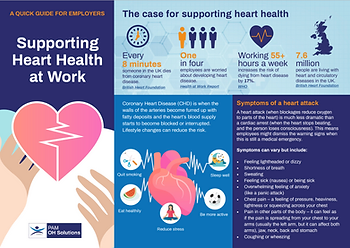
Focus on heart health this International Women’s Day
With UK women twice as likely to die from coronary heart disease as breast cancer, it’s important to ensure this isn’t just seen as a man’s disease.
According to the British Heart Foundation, women are needlessly dying because heart attacks are often seen as a man’s disease, even though twice as many UK women die of coronary heart disease as breast cancer each year.
Not only are women less likely than men to receive lifesaving treatments and the correct diagnosis and medicine after a first heart attack, but they’re also less likely to recognise the symptoms of a heart attack.
In the run up to International Women’s Day (8 March 2023) our medical director, Dr Bernard Yew, explores four ways employers can help to reduce this health inequality.
Four ways to reduce the heart health gender gap
1. Provide education tailored to women as well as men
Awareness and education of the symptoms of heart attacks in women is essential for preventing fatalities. However, the widely publicised symptoms of a heart attack, including chest pressure and pain radiating up an arm, are not always experienced by women.
Women can also experience a heart attack with little to no symptoms and no chest pressure, in what is often dubbed a ‘silent heart attack’. This can consist of much milder symptoms, such as shortness of breath, light-headedness, feelings of nausea or indigestion and sweating.
Lack of awareness of these symptoms means women are less likely to seek the urgent help required, contributing to almost one in two (47%) experiencing heart failure, stroke or death within five years of a first heart attack, compared to just 36% of men. To counteract this, make sure both men and women are made aware of all the potential symptoms of a heart attack and encouraged to seek urgent medical attention if they experience these symptoms.
Pellentesque varius aliquam felis, luctus venenatis mauris aliquam eget. Fusce eget vulputate lorem, at ornare elit. Pellentesque in mattis enim. Cras tincidunt a nisl vitae mollis. Vivamus nec volutpat odio. Suspendisse gravida, ipsum non vestibulum consectetur, nunc libero blandit nunc, id laoreet massa nisl sed nisl. Nam non ultrices nisl. Phasellus eget tortor at lectus vestibulum ornare ut ac orci. Quisque id magna bibendum, tincidunt diam vitae, aliquam nunc. Cras vel viverra augue.
Symptoms of a heart attack can include:
- Feeling lightheaded or dizzy
- Shortness of breath
- Sweating
- Feeling sick (nausea) or being sick
- Overwhelming feeling of anxiety (like a panic attack)
- Chest pain – a feeling of pressure, heaviness, tightness or squeezing across your chest
- Pain in other parts of the body – it can feel as if the pain is spreading from your chest to your arms (usually the left arm, but it can affect both arms), jaw, neck, back or stomach
- Coughing or wheezing
2. Empower women to get support
Women are 50% more likely to get the wrong diagnosis after a heart attack and less likely to receive lifesaving treatments. A study by the University of Leeds found that more than 8,200 heart attack deaths among women, over a ten year period, could have been prevented if they had received equal treatment to men.
The symptoms of heart disease (when the arteries become furred up with fatty deposits) or a heart attack (when blockages reduce oxygen to parts of the heart) are much less dramatic than a cardiac arrest (when the heart actually stops beating and the person loses consciousness). This means many women might dismiss the warning signs of heart disease as being due to something else, or think their symptoms are not severe enough to trouble the NHS.
To help avoid this, managers and HR should keep an eye out for individuals who are experiencing frequent short-term absence and encourage them to talk to their GP, or refer them into Occupational Health, instead of allowing them to brush their symptoms aside. Even something as seemingly unimportant as feeling very fatigued, ongoing heartburn, tummy pain or nausea could be an underlying sign of something more serious.
3. Promote positive lifestyle changes
Encourage employees to take up any employer sponsored health MOTs or go for the free health check provided by the NHS every five years, to people over the age of 40. Those with a family history of heart disease can also request more regular health checks. These checks are designed to help detect the early signs of heart disease, and other conditions, and advise people how to take positive steps to reduce their risks.
Simple lifestyle changes, such as quitting smoking, taking more exercise and eating more healthily can help to reduce the risk of heart disease. As can reducing stress levels, with research by the World Health Organisation showing that working 55 hours or more a week increases the risk of developing heart disease by 17%.
Unfortunately, many women can use setting health goals as a stick to beat themselves with, by just putting unrealistic pressure on themselves to lose weight. By helping them set more personally meaningful health goals, such as reducing health risks so they can avoid heart disease and be there for their kids, you can increase their chances of success and help reduce the negative focus on body image that has led 91% of women to say they hate their bodies.
4. Make reasonable adjustments
3.6 million women are living with heart and circulatory diseases in the UK. This makes supporting them to stay in work an important diversity consideration, which is only set to become more important due to an aging workforce. Heart disease is also a condition that is protected under the Equality Act, so it’s important to work with both the employee and their manager to find a way forward.
Start by looking at what reasonable adjustments can be made to allow the employee to remain in work following diagnosis of heart disease. For example, if they have had balloons and stents inserted into narrow arteries due to heart disease, they will be restricted from lifting heavy objects. Whereas if they are feeling more easily fatigued following a mild heart attack, they might need to work shorter shifts or on a part-time basis while they recover.
Occupational Health can help by identifying what the employee can safely do and consulting with managers, before assessing the employee, to deliver an actionable return-to-work plan that minimises absence and works for both the employer and employee.
Free Quick Guide: How to support heart health at work

Download our free guide for managers and employees on spotting the signs of a heart attack and ways to reduce the risk of this happening. Including tips for both men and women.
How we can help…
At PAM OH, we are committed to helping you to prevent sickness absence by putting in place education, risk assessment and support services that help people to stay healthy. Our cardiovascular support services include:
Occupational health assessment – to identify how cardiovascular disease is impacting an individual at work and suggest reasonable adjustments to work.
Employee Assistance Programme (EAP) – confidential telephone access to mental health counsellors providing emotional support and practice advice.
Heart health workshops – to educate employees about the symptoms of a heart attack, what to do and how best to get the support and treatment needed.
Manager workshops – practical sessions to educate managers about the cardiovascular disease and how it can impact on people at work.
To set up a free consultation to discuss ways of managing cardiovascular disease at your organisation, please email us at info@pamgroup.co.uk – or contact your PAM Account Manager.
Related Insights
Flu season is coming early – is your workplace ready?
How to respond to the rise in employee drug and alcohol use
Reducing work-related illness with health surveillance
Occupational health insights on keeping your people healthy and productive
Want to have our latest research, case studies and opinions
delivered straight to your inbox?





